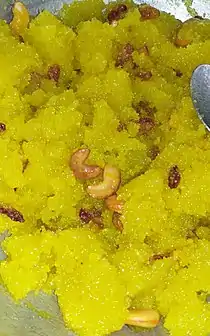Suji ka Halwa
Semolina, when made sweet, is called sheera. Several variants of this dish are available under other names in various parts of India. For instance, in Maharashtra, it is called sheera which is the sweet version and in North India it is called sooji (suji) halwa or Mohan bhog. In the Caribbean it is known by Indo-Caribbeans as Mohan bhog or simply just as parsad, as it is a common sweet that Hindu Indo-Caribbeans charhaway or offer as prasad in pujas.[1] It is called Sajjige in parts of Tulunadu. It is also served in Europe and United States as semolina pudding.
.jpg.webp) | |
| Alternative names | Mohan bhog, Sheera, sooji halwa |
|---|---|
| Type | Indian desserts, Breakfast |
| Place of origin | India |
| Region or state | Indian subcontinent |
| Main ingredients | semolina, sugar, ghee, milk |
Suji is a Cuisine of India and a kesar/saffron-flavored variation of this is the Kesari sheera. Suji is served as a breakfast or a dessert item. The normal variety though is unflavoured and prepared with just semolina, sugar, ghee, and milk.
As it is easy to prepare, it is often favored as a breakfast item, especially with pooris, in other parts of India. It is also referred as traditional recipe in progmmes or meal
Historical usage

The dish is listed as shali-anna in Manasollasa, a 12th century work by a south Indian Chalukyan king Someshvara III.[2] In south India presently the dish is called Kesari Bat.
Additionally In Medieval Arab cuisine, semolina was cooked with water, honey, camphor, saffron, and sesame oil.[3] In 14th-century Spain, semolina was cooked with almond milk, oil and optionally saffron for coloring . in India sheera is made from semolina, ghee sugar cardamom and milk almonds and cashwnuts are added in it[4] In England circa 1845, baked semolina puddings were recommended by renowned cooks such as Eliza Acton.[5]

See also
References
- http://nandasahadeo.blogspot.com/2011/05/mohan-bhogprasaadparsaad.html
- "Full text of "Indian Food Tradition A Historical Companion Achaya K. T."". archive.org. Retrieved 2019-01-30.
- Rondinson, Maxime; et al. (1998). Medieval Arab Cookery, essays and translations. Prospect Books. pp. 423–424. ASIN 0907325912.
- Santanach, Joan (2008). The Book of Sent Sovi: Medieval recipes from Catalonia. Tamesis Books. ISBN 978-1855661646.
- Acton, Eliza (1882). Modern Cookery for Private Families.
